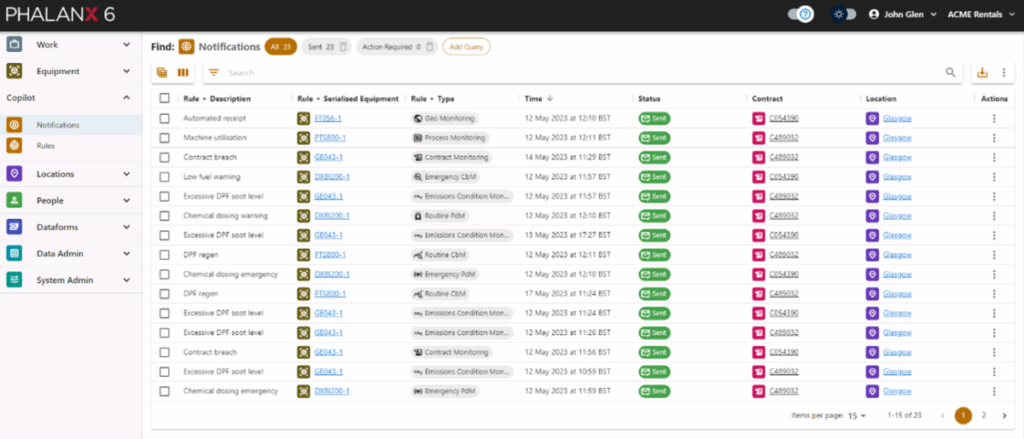Equipment Telematics and AI: Revolutionising Rental
Equipment rental companies can now leverage the power of equipment telematics and Artificial Intelligence (AI) to unlock new opportunities for revenue growth and operational efficiency. Customers are willing to pay for enhanced surveillance of mission-critical equipment like pumps and generators. And rental companies can reduce maintenance costs by moving towards condition-based and predictive maintenance.
However, rental companies face significant challenges that must be overcome to unlock the value of this technology.
Challenge 1: Fragmented Telematics Data
The issue of telematics data islands looms over the industry. Telematics units enable the seamless transmission of engine management data to a web portal via the mobile network. Each equipment manufacturer has separate data portals for their machinery, resulting in fragmented information.
To address this, rental companies must consolidate the data from various portals into a centralised data lake. This data lake acts as the beating heart of the operation, constantly updated in near real-time as equipment information changes dynamically in the field.
Challenge 2: Combining Telematics and Operational Data
Rental equipment is in constant motion, shifting between customers, contracts and job sites. To provide the value-added services that customers are willing to pay extra for, rental companies must merge telematics data with operational information.
By doing this, rental companies can extract valuable insights to develop new billable services. This combination of equipment telematics and operational context provides contract-specific alerts and recommendations, proactive maintenance, and enhanced customer experiences.
Challenge 3: Capturing Expert Knowledge
The third and final hurdle is capturing and applying expert knowledge across a wide range of equipment. To deliver new billable services and reduce operating costs, rental companies must utilise the expertise of the product experts in their workforce and equipment suppliers. The challenge lies in effectively incorporating this expert knowledge into the telematics and operational data ecosystem.
Rental companies can then leverage artificial intelligence (AI) to automate processes, extract insights, and make informed decisions based on the combined wisdom of their experts and the power of data.
How Rental Copilots Use Artificial Intelligence to increase revenue and reduce costs
Enter Spartan Solutions Equipment Rental Copilots, an innovative solution introduced in PHALANX 6. These copilots use AI techniques to analyse telematics and operational data constantly.
In collaboration with your equipment experts and Spartan data scientists, AI rules are built to power the PHALANX Copilots. When a copilot rule triggers, an event is promptly sent to the Hire Control team, enabling swift action or automatic processing.
Example Copilots for the Rental Industry
These copilots exemplify the potential of merging equipment telematics and rental AI:
- Process Monitoring and Alerts: Copilots keep a watchful eye on equipment output, notifying operators when it reaches or is predicted to reach a critical threshold. This enables proactive decision-making, preventing potential failures and ensuring uninterrupted productivity.
- Condition-Based Maintenance: By utilising telematics data, copilots automatically generate service work orders, enabling rental companies to implement timely maintenance procedures. This proactive approach minimises equipment downtime and optimises operational efficiency.
- Contract Monitoring and Alerts: Copilots actively track customer usage and promptly alert rental companies when customers breach agreed-upon usage thresholds. This allows swift intervention, ensuring compliance and facilitating transparent communication between parties.
- Emissions Monitoring and Alerts: Copilots play a crucial role in environmental stewardship by monitoring equipment emissions. When excessive emissions are detected, immediate alerts are triggered, enabling companies to address the issue promptly and minimise environmental impact.
- Geo Monitoring and Alerts: Copilots leverage geofencing technology to monitor equipment location. Alerts are generated whenever equipment enters or exits a designated area, providing real-time visibility and facilitating efficient fleet management.

The PHALANX Copilot uses industry-standard telematics interfaces to capture and combine information from multipe equipment manufacturers. This enables the creation of a comprehensive data lake, serving as the central repository for all telematics data.
The data lake constantly synchronises with operational information from PHALANX, Rental Management, and Customer Relationship Management systems. The result is an interconnected data stream that allows rental equipment experts to develop rules capable of continuous equipment monitoring, 24/7, 365 days a year.
In conclusion, equipment telematics combined with the power of AI represents a paradigm shift for the equipment rental industry. Overcoming the challenges of data fragmentation, merging telematics with operational data, and capturing expert knowledge paves the way for increased revenue and reduced operational costs.
Spartan’s Equipment Rental Copilots, integrated within the PHALANX 6 ecosystem, enable rental companies to tap into the potential of telematics and AI, propelling them to the forefront of the industry. With these copilots by their side, rental companies can navigate the increasing complexities of the industry with unwavering confidence, unlocking new opportunities for growth and success.